The Centre has, over the last one and a half decades, been implementing a multi-pronged strategy to “rationalise” its subsidy expenditure. It sought to set limits on these expenses via decontrol of retail prices of auto fuels, removal of liquefied petroleum gas (LPG) subsidy for those who can afford market prices, and by introducing “fixed-rate-subsidy” for phosphorus and potassium (P&K) fertilisers. Simultaneously, a series of administrative and technology-enabled steps like end-to-end computerisation of public distribution system operations have helped improve efficiency of delivery. Better targetting and new products like nano urea have allowed significant savings to the exchequer.
Also, the 2020-21 Budget saw a radical shift to complete recognition of subsidy financing in the Budget, with one-time settlement of the Food Corporation of India’s (FCI) accumulated loans of Rs 3.8 lakh crore to the National Small Savings Fund. Since subsidy funds are now being transferred to the FCI rather promptly, it doesn’t have to take costly short-term loans.
While all this is kosher, the fact is that a substantial part of the subsidy regime continues to be open-ended. Further reforms are very much warranted, to make more public monies available for meeting other pressing requirements, including for fixed assets creation and spending on health and education. For instance, it is common knowledge that sections of the 810 million beneficiaries of the free-grains scheme are undeserving of the largesse.
True, the Pradhan Mantri Garib Kalyan Yojana (PMGKAY) is now shorn of the hugely expensive “extra” element (doubling of the distributed grain quantities), the implementation of which in the aftermath of Covid had cost the exchequer a staggering Rs 3.43 lakh crore. Also, over 95% of the PMGKAY grains are now being distributed using electronic point of sale devices at fair price shops, with biometric Aadhaar authentication.
Yet, as this newspaper reported recently, food subsidy expenses for FY25 may cross Rs 2.25 lakh crore, up Rs 20,000 crore from the Budget estimate. The PMGKAY beneficiary pool needs to be redefined without any further delay, by making use of data sources like the census and surveys on household consumption. Dynamic and calibrated adjustments need to be made in the light of fresh data, and in keeping with verifiable official estimates of poverty incidence.
As for fertiliser subsidy too, the issue prices (MRP) to the farmers haven’t been revised for long years for both urea and P&K fertilisers, though costs have spiralled out of control due to a large import element. The fixed-subsidy policy for P&K, announced in 2010, has existed only on paper. Diversion and misuse of the subsidy for soil nutrients are still being reported, but direct benefit transfer is yet to be implemented.
Consumption of LPG by Ujjwala Yojana beneficiaries has lately improved to over four refills/year, as prices have been kept unchanged since March 2024. Oil companies are up with a Rs 35,000-crore subsidy bill, while only Rs 12,000 crore is budgeted for FY25.
The additional spend is justified as clean cooking fuel at affordable prices for the low-income population is of great economic value. To be sure, as a fraction of the Budget, the three explicit subsidies have been on the decline — from 12.7% in FY23 to 9.3% in FY24 — but might end up a bit higher than 7.9% budgeted in the current year. It is feasible to rein in these expenses well below 1% of the GDP, without causing any hardship for the intended beneficiaries.

